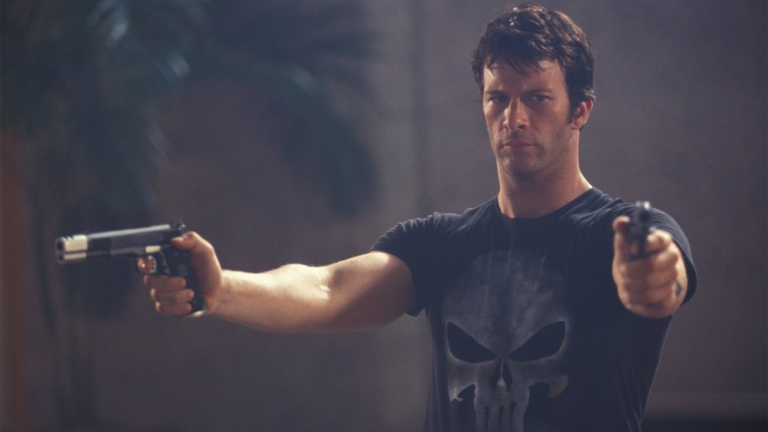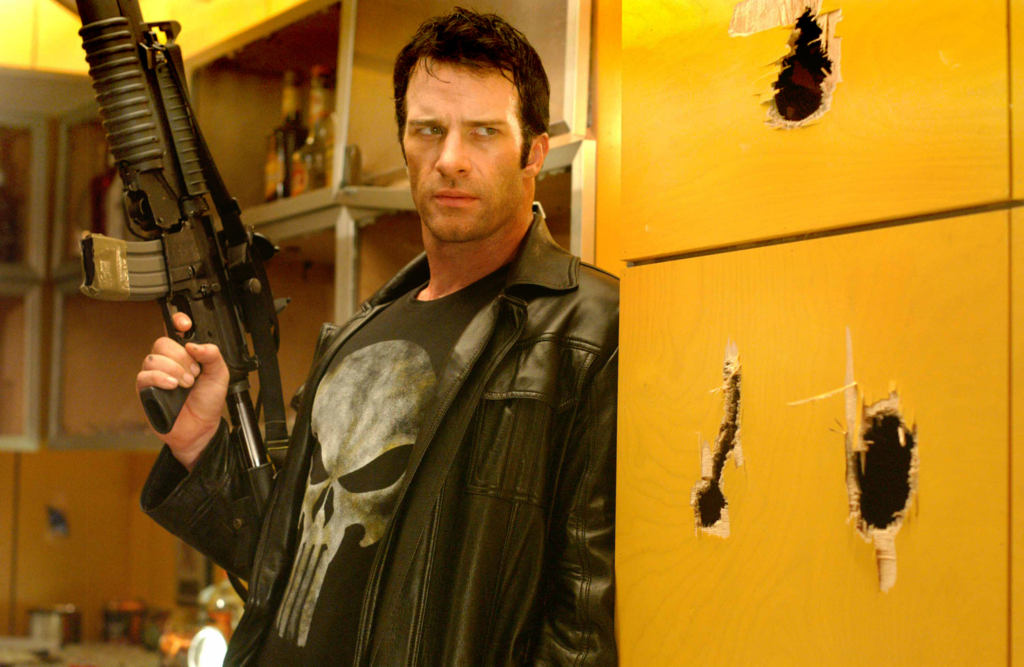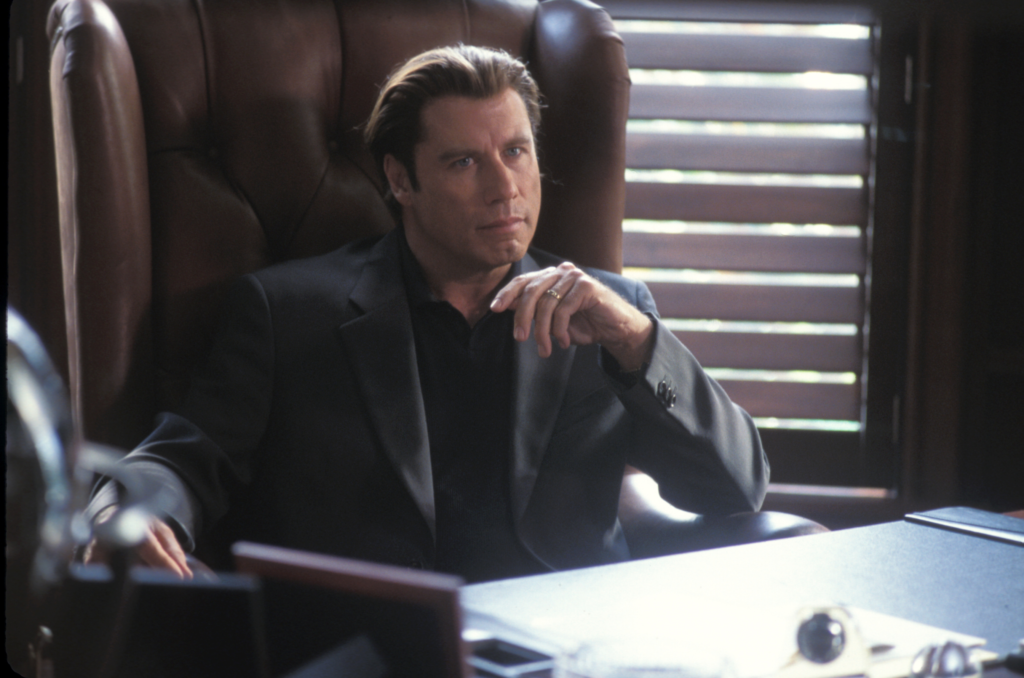

How ‘The Punisher’ avoids the beloved spectacle of comic book movies and goes for something much darker and more ultimate.
The Punisher (2004) trades the explosiveness of the 1989 film for the unapologetic violence of the films that inspired the character. It avoids the beloved spectacle of comic book movies and goes for something much darker.
As a child, I feverishly clung to anything comic book-related, from watching my older cousin play Spider-Man on the PlayStation One to watching the X-Men animated series on Fox every Saturday morning.
Although I never read many comic books during that time, my admiration for the medium was neverending thanks to video games, television, and mostly film. I saw Spider-Man (2001) and Daredevil (2003) on the big screen when I was young, but the film that left the biggest impression on me was one I saw on TV a couple of years after its release.
I am referring to none other than The Punisher (2004).
UAMC Reviews ‘The Punisher’ (2004)
Based loosely on the comic book series, Welcome Back, Frank and The Punisher: Year One, the film follows FBI agent Frank Castle’s quest for revenge after his entire family is murdered under the orders of crime boss Howard Saint (John Travolta) in retaliation for Castle inadvertently killing Saint’s son Bobby during a sting operation. The film marks the directorial debut of Jonathan Hensleigh (the writer responsible for Die Hard with a Vengeance and Armageddon). He plants his feet close to those roots of 70’s vigilantism the character is known for.
If you have the smallest amount of comic book knowledge, it wouldn’t be difficult to figure out that most characters are usually tied to a specific location. Similar to how Daredevil and Spider-Man live and breathe New York, The Punisher is a staple to New York vigilantes in the Marvel Universe. So, the elephant in the room is that the film trades the usual dark and grim atmosphere of New York for the sun-filled sky of Florida. While New York is integral to The Punisher, the change of setting in the film never feels as if it is a hindrance thanks to Thomas Jane’s devoted performance.
Before filming, Jane took part in a six-month-long NAVY SEAL training regiment; it becomes very apparent in his physique (gaining 20 lbs of muscle) and when he gets his hands wrapped around a weapon. If the training was not enough to convince you of his devotion, Thomas Jane did most of his stunts in the film as well. Emotionally, it’s easy to see echoes of Paul Kersey or Harry Callahan in his steely cool rage, but he manages to carve out his own space in the “man out for revenge” corner. Where Dolph Lundgren’s Frank Castle was a gun-wielding zombie towering over victims, Jane’s Punisher has the face of a man who has been stripped of everything and reborn to float through the world as a raw nerve.
Thomas Jane vs John Travolta

Opposite Thomas Jane is John Travolta as Howard Saint. At first, he felt like a lousy proxy for the well-known villain Kingpin. But through repeat viewings, it becomes clear that the character’s hammy-ness is more of a compensation for his frail ego. He comes across as an abhorrent monument crumpling in a sweaty panic. Around his wife and his underlings, he reeks of insecurities, clawing for control. While Frank Castle methodically tears his life apart, it becomes clear that he does not own his empire, his empire owns him. Once that empire implodes, his death is brutal and cathartic.
Those familiar with the comics will quickly recognize the supporting cast, which includes Spacker Dave (Ben Foster), Bumppo (John Pinette), and Joan (Rebecca Romijn). The three friends Frank Castle reluctantly meets in his apartment building provide brief instances of humor reminiscent of the comics. But more importantly, they offer Castle some way out of the pool of sadness he’s drowning in, they motivate him to become a “hero.” In a minor role that would be a disservice to go without acknowledging, is Roy Scheider as Frank Castle Sr. In the short time with him, you can see the type of man he raised Frank Castle to be as he jumps to action during the beach assault.
When you watch the film you’ll notice the supporting character Jimmy Weeks (A. Russel Andrews) disappears halfway through. This is only because his subplot was left on the cutting room floor and can only be found on the director’s cut. The subplot involves him being the reason Saint can locate Castle’s family, from there it takes a very dark turn. If you watch the director’s cut You’ll also find a prologue that centers around Frank’s and Jimmy’s time in the military. Deemed too expensive to film, Tim Bradstreet’s art and photographs were used to create a motion comic.
But How Ultimate is it?
The film turns Castle’s heartbreaking murder of his nuclear family into a cold-blooded killing of his entire family. This sets the stage for the rest of the violence in the film. Where most comic book adaptations give way to action steep in violence designed for spectacle, The Punisher goes in the opposite direction. There aren’t winners or losers, only survivors. With clarity, the audience is confronted with the blunt impact of the action. You can’t help but feel the influence of 1970s action films. It is even possible to find Hensliegh and cinematographer Conrad W. Hall ripping shots from Dirty Harry and using the cowboy shot several times throughout the film.
It would be criminal not to mention the standout fight featuring WWE legend Kevin Nash as The Russian. This fight is one of the many instances where we see Castle’s tolerance for pain and his ability to survive. Additionally, there’s the perfect use of their environment with a great sense of escalation that ends in one of the most gruesome images of the film. Practical effects and crude action give the violence a real sense of authenticity. With Taxi Driver, Scorsese likened Travis Bickle to a crab by having him move in very straight lines. Frank Castle resembles a shark, devouring everything in his path and only moving forward. Whether a knife to the mouth, an arrow to the neck, or boiling water to the face, each bit of cruelty sinks its teeth into you.
While bolstered by Thomas Jane’s outstanding performance in the titular role, The Punisher (2004) trades the explosiveness of the 1989 film for the unapologetic violence of the films that inspired the character. It avoids the beloved spectacle of comic book movies and goes for something much darker. The grim and bloody story might not cover any new ground, however, I don’t believe it wants to. It only cares more about the execution, and that’s all that matters.
Article By: Cameron Levins is a filmmaker, comic book lover and fight scene enthusiast. Ever since his dad showed him Bruce Lee as a kid, he became obsessed with action films. In his free time he’s either day dreaming about an action scene or researching fight choreographers. Follow Cameron on Twitter here.